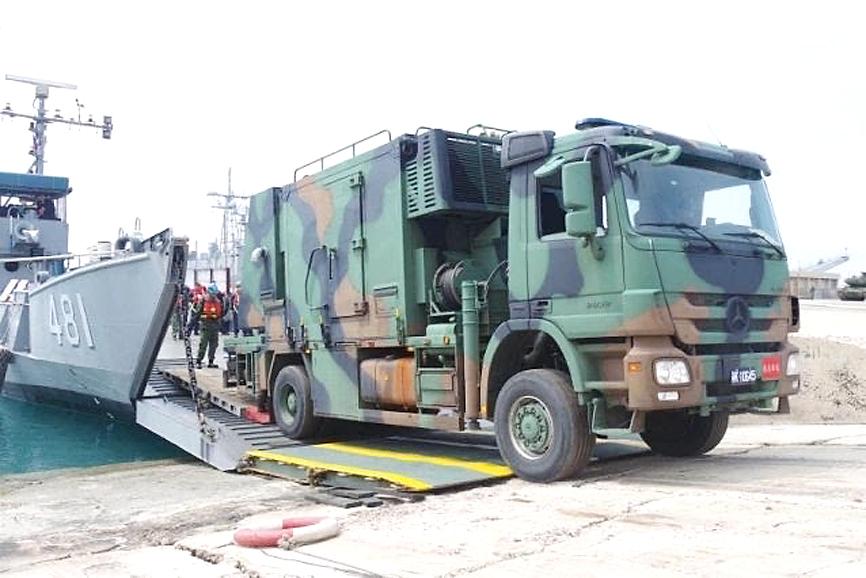The Ministry of National Defense yesterday denied that there were mass dismissals after reportedly classified images of a top-secret radar system were leaked to the military’s own Youth Daily News.
The online article published on March 26 — which has since been taken down — reported on the Navy 151st Amphibious Fleet’s mission to resupply Magong City (馬公) in Penghu County, and was purportedly written by a political warfare officer serving on the tank landing ship ROCNS Chung Ho.
While the article itself did not contain sensitive information, highly classified aspects of a mobile anti-stealth passive radar system designed by the Chungshan Institute of Science and Technology were visible in two images used for the report.

Screen grab from the Youth Daily News Web site
First deployed in 2018, the radar system is reportedly capable of detecting the Chinese People’s Liberation Army’s (PLA) much-vaunted J-20 stealth fighter.
The images were republished on Monday last week by the English-language military aviation Web site Alert5 in an article titled “Taiwan Has Deployed Anti-Stealth Passive Radar System in Penghu.”
The Chinese-language Apple Daily reported that the ministry was unaware of the breach until US officials contacted Taipei via national security channels, while the Liberty Times (sister paper of the Taipei Times) said that some of the officials were with the American Institute in Taiwan.
The misstep angered Minister of National Defense Chiu Kuo-cheng (邱國正), the Apple Daily added.
Yesterday, Chiu had disciplinary investigations opened on as many as 100 officers of the Naval Fleet Command and the Political Warfare Bureau, which runs the Youth Daily News, the Apple Daily said, citing an anonymous source reported to be a general officer at the ministry.
More than 20 officers could receive reprimands or other disciplinary actions over the secrecy breach, it quoted the source as saying.
“An earthquake is coming to the ministry,” the source added.
“Operational security is a basic component of a soldier’s duty and the command has consistently demanded that each soldier be intimately familiar with operational security procedures and thoroughly implement them,” the Navy Command said in a statement.
An image of a mobile passive bistatic radar system was displayed at the 2013 Taipei Aerospace and Defense Technology Exhibition.
The display text provided by the institute said that the vehicle’s beamforming capabilities could act in combination with active radar or sources to detect aerial targets.
The long-distance system’s receivers use a different angle than active radar to detect a target and the absence of radar emissions helps it to evade countermeasures, the text said.

The US government has signed defense cooperation agreements with Japan and the Philippines to boost the deterrence capabilities of countries in the first island chain, a report by the National Security Bureau (NSB) showed. The main countries on the first island chain include the two nations and Taiwan. The bureau is to present the report at a meeting of the legislature’s Foreign Affairs and National Defense Committee tomorrow. The US military has deployed Typhon missile systems to Japan’s Yamaguchi Prefecture and Zambales province in the Philippines during their joint military exercises. It has also installed NMESIS anti-ship systems in Japan’s Okinawa

‘WIN-WIN’: The Philippines, and central and eastern European countries are important potential drone cooperation partners, Minister of Foreign Affairs Lin Chia-lung said Minister of Foreign Affairs Lin Chia-lung (林佳龍) in an interview published yesterday confirmed that there are joint ventures between Taiwan and Poland in the drone industry. Lin made the remark in an exclusive interview with the Chinese-language Liberty Times (the Taipei Times’ sister paper). The government-backed Taiwan Excellence Drone International Business Opportunities Alliance and the Polish Chamber of Unmanned Systems on Wednesday last week signed a memorandum of understanding in Poland to develop a “non-China” supply chain for drones and work together on key technologies. Asked if Taiwan prioritized Poland among central and eastern European countries in drone collaboration, Lin

Renewed border fighting between Thailand and Cambodia showed no signs of abating yesterday, leaving hundreds of thousands of displaced people in both countries living in strained conditions as more flooded into temporary shelters. Reporters on the Thai side of the border heard sounds of outgoing, indirect fire yesterday. About 400,000 people have been evacuated from affected areas in Thailand and about 700 schools closed while fighting was ongoing in four border provinces, said Thai Rear Admiral Surasant Kongsiri, a spokesman for the military. Cambodia evacuated more than 127,000 villagers and closed hundreds of schools, the Thai Ministry of Defense said. Thailand’s military announced that

CABINET APPROVAL: People seeking assisted reproduction must be assessed to determine whether they would be adequate parents, the planned changes say Proposed amendments to the Assisted Reproduction Act (人工生殖法) advanced yesterday by the Executive Yuan would grant married lesbian couples and single women access to legal assisted reproductive services. The proposed revisions are “based on the fundamental principle of respecting women’s reproductive autonomy,” Cabinet spokesperson Michelle Lee (李慧芝) quoted Vice Premier Cheng Li-chiun (鄭麗君), who presided over a Cabinet meeting earlier yesterday, as saying at the briefing. The draft amendment would be submitted to the legislature for review. The Ministry of Health and Welfare, which proposed the amendments, said that experts on children’s rights, gender equality, law and medicine attended cross-disciplinary meetings, adding that